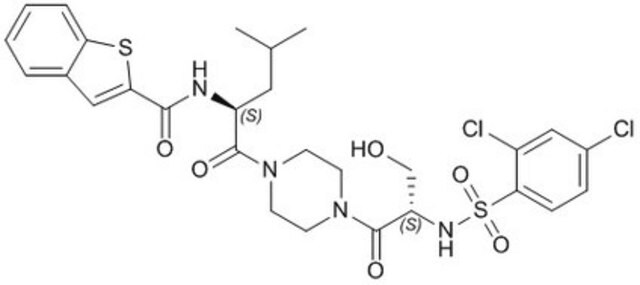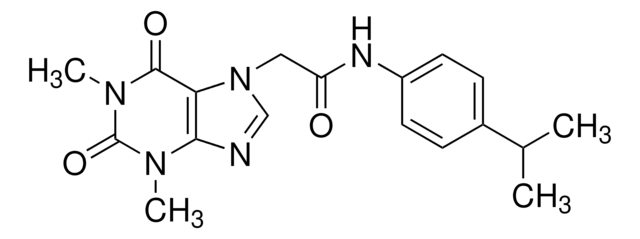추천 제품
Quality Level
분석
≥98% (HPLC)
형태
powder
색상
white to beige
solubility
DMSO: >5 mg/mL, clear
저장 온도
room temp
InChI
1S/C37H38BrF3N4O/c38-28-12-13-30-32(23-28)42-34(25-8-7-11-27(22-25)37(39,40)41)31(24-44-20-14-29(15-21-44)45-18-5-2-6-19-45)33(30)35(46)43-36(16-17-36)26-9-3-1-4-10-26/h1,3-4,7-13,22-23,29H,2,5-6,14-21,24H2,(H,43,46)
InChI key
UIVOZBSCHXCGPS-UHFFFAOYSA-N
애플리케이션
GSK2193874 has been used as a transient receptor potential vanilloid 4 (TRPV4) antagonist:
- to study its effects on GSK101-induced colon contractions in mice
- to study its effects on murine compact bone-derived osteoblasts(CB-OB)
- to study its effects on lung injury post-lipopolysaccharide (LPS) in mice
생화학적/생리학적 작용
GSK2193874 is a very potent, specific antagonist of TRPV4 ion channels (IC50 = 50 nM). Lung edema caused by high pulmonary venous pressure (PVP) is driven by TRPV4 activity. GSK2193874 blocks TRPV4-mediated calcium influx in cells expressing native and recombinant TRPV4, and inhibits vascular permeability and lung edema in isolated rodent and canine lungs subjected to high PVP. The compound also resolves pulmonary edema in murine myocardial infarction model.
신호어
Danger
유해 및 위험 성명서
Hazard Classifications
Acute Tox. 3 Oral - Eye Irrit. 2 - Skin Irrit. 2 - STOT SE 3
표적 기관
Respiratory system
Storage Class Code
6.1C - Combustible acute toxic Cat.3 / toxic compounds or compounds which causing chronic effects
WGK
WGK 3
Flash Point (°F)
Not applicable
Flash Point (°C)
Not applicable
시험 성적서(COA)
제품의 로트/배치 번호를 입력하여 시험 성적서(COA)을 검색하십시오. 로트 및 배치 번호는 제품 라벨에 있는 ‘로트’ 또는 ‘배치’라는 용어 뒤에서 찾을 수 있습니다.
이미 열람한 고객
Sheikh Rayees et al.
Cell reports, 27(3), 793-805 (2019-04-18)
Alveolar macrophages (AMs), upon sensing pathogens, trigger host defense by activating toll-like receptor 4 (TLR4), but the counterbalancing mechanisms that deactivate AM inflammatory signaling and prevent lethal edema, the hallmark of acute lung injury (ALI), remain unknown. Here, we demonstrate
Jialie Luo et al.
Immunity, 49(1), 107-119 (2018-07-01)
Intestinal macrophages are critical for gastrointestinal (GI) homeostasis, but our understanding of their role in regulating intestinal motility is incomplete. Here, we report that CX3C chemokine receptor 1-expressing muscularis macrophages (MMs) were required to maintain normal GI motility. MMs expressed the
Elena Cambria et al.
Cells, 9(7) (2020-07-28)
Mechanical loading and inflammation interact to cause degenerative disc disease and low back pain (LBP). However, the underlying mechanosensing and mechanotransductive pathways are poorly understood. This results in untargeted pharmacological treatments that do not take the mechanical aspect of LBP
Tomasz Janczi et al.
Cells, 10(10) (2021-10-24)
Mechanotransduction is elicited in cells upon the perception of physical forces transmitted via the extracellular matrix in their surroundings and results in signaling events that impact cellular functions. This physiological process is a prerequisite for maintaining the integrity of diarthrodial
Nicholas Mikolajewicz et al.
eLife, 7 (2018-10-17)
Bone cells sense and actively adapt to physical perturbations to prevent critical damage. ATP release is among the earliest cellular responses to mechanical stimulation. Mechanical stimulation of a single murine osteoblast led to the release of 70 ± 24 amole
자사의 과학자팀은 생명 과학, 재료 과학, 화학 합성, 크로마토그래피, 분석 및 기타 많은 영역을 포함한 모든 과학 분야에 경험이 있습니다..
고객지원팀으로 연락바랍니다.














